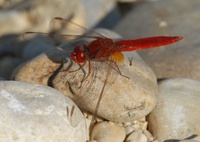
People use more and more land area worldwide. In 2000 nearly one quarter of Earth’s net production of biomass was harvested, burnt or could not grow due to human land use. Natural vegetation is removed for farm land, cities and roads, as in densely populated Europe and currently in many countries with tropical forests. Lakes, rivers and the sea are managed intensively. Therefore the survival of many species is threatened. “Climate change will aggravate this situation by further reducing habitats of plant and animal species and by disturbing natural ecosystem processes,” says Wolfgang Cramer, co-chair of PIK’s research domain “Earth System Analysis”. Globally, Arctic as well as coastal habitats, such as reefs and mangrove forests are endangered most. Besides the “biodiversity hot spots”, mostly in tropical areas, also cultural landscapes as reservoirs of biodiversity are in danger to disappear because of climatic change.
Computer simulations at PIK, carried out for the Fourth Assessment Report by the Intergovernmental Panel on Climate Change, demonstrate how climate change will alter almost all ecosystems on Earth. Forests invade the treeless Arctic tundra, while at its southern border forest cover is thinning due to increasing dryness. In mixed forest deciduous tree species increase while coniferous decline. Increasing aridity already alters ecosystems in southern Africa and may put further stress on Latin-American rainforests. “Pressure on earth’s ecosystems will increase dramatically unless we alter course,” says Wolfgang Lucht, co-chair of PIK’s research domain “Climate Impacts & Vulnerabilities”. Where ecosystems only survive within borders of island-like protected areas, they cannot “make way” to climate forcing and develop anew at another place. “This is another dire reason for halting global warming at two degrees,” says Lucht.

„In Germany climate impacts on biodiversity are not as dramatic as elsewhere,” says Katrin Vohland, who is co-chairing the PIK-project “Biodiversity and Vulnerability of Ecosystem Services” with Wolfgang Cramer. This project looks at how change of climate and land use affects regional ecosystems and options of adaptation. In some areas of Germany dryness is increasing and endangering the remaining wetland areas. Also, species adapted to a colder climate like alpine plants and remaining isolated species from the last ice age are declining. However, thermophilic species like Mediterranean dragonflies and butterflies are migrating northwards so species numbers are currently rising in some areas. In the long run, should climate change precede unabated, biodiversity and its functions would be lost, though, since climate would change faster than species could adapt their natural range.
But human land use remains to be the largest direct threat to biodiversity. Assuming a growth of the world’s population of two billion people until 2050 even more space will be occupied by humans. Agricultural practices will also have to be intensified to secure food production. The increase of demand for agricultural and natural products will be disproportionally high in centers of economic growth. “Our calculations show the need to thoroughly coordinate land use globally, to avoid destabilizing the triangle of environmental protection, food production and future production of bioenergy,” says Lucht. Market forces alone will fail to achieve this goal. PIK simulations of space that could be used for bioenergy plantations indicate that with strict environmental regulations 10 to 15 percent of today’s global demand for primary energy could be supplied by biomass without interfering with environmental goals.
Several international organizations need to act decidedly in order to limit climate change as well as the loss of biodiversity. Actions should be based on Earth system analytic sciences that consider all relevant factors: protection of the environment and natural habitat, demographics, technology, food production, energy supply, and climate.
PIK investigates risks of climatic change for the goals of protection of the environment together with German and international partner organizations: in a collaborative project financed by the Federal Agency for Nature Conservation for protected areas in Germany and in the project ALARM for the European Union. The goal is to find better strategies for adaptation of nature conservation such as the European network Natura 2000. Internationally PIK supports the development of programs of compensation for avoided deforestation, especially in tropical countries (REDD). The Leibniz-Association, that PIK belongs to, investigates changes to natural habitats through climate change and increasing land use within the projects “Biosphere and Society” and “BioEnergyPlanet”.
Further information:
Protected Areas in Germany under Global Change - Risks and Policy Options
Contact at PIK:
Press office
Phone: ++49 (331) 288-2507, E-mail: press(at)pik-potsdam.de





